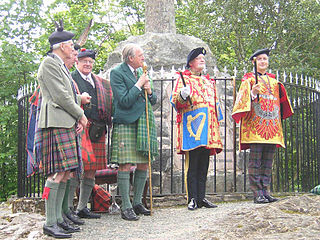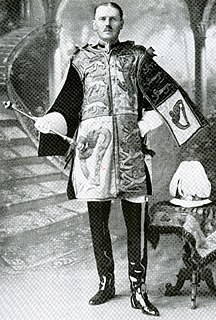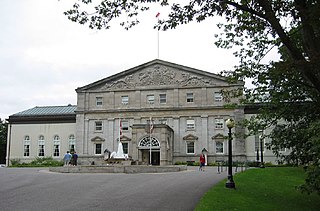
A coat of arms is a heraldic visual design on an escutcheon, surcoat, or tabard. The coat of arms on an escutcheon forms the central element of the full heraldic achievement which in its whole consists of shield, supporters, crest, and motto. A coat of arms is traditionally unique to an individual person, family, state, organization or corporation.

An officer of arms is a person appointed by a sovereign or state with authority to perform one or more of the following functions:

A pursuivant or, more correctly, pursuivant of arms, is a junior officer of arms. Most pursuivants are attached to official heraldic authorities, such as the College of Arms in London or the Court of the Lord Lyon in Edinburgh. In the mediaeval era, many great nobles employed their own officers of arms. Today, there still exist some private pursuivants that are not employed by a government authority. In Scotland, for example, several pursuivants of arms have been appointed by Clan Chiefs. These pursuivants of arms look after matters of heraldic and genealogical importance for clan members.

King of Arms is the senior rank of an officer of arms. In many heraldic traditions, only a king of arms has the authority to grant armorial bearings and sometimes certify genealogies and noble titles. In other traditions, the power has been delegated to other officers of similar rank.

A private officer of arms is one of the heralds and pursuivants appointed by great noble houses to handle all heraldic and genealogical questions.
Assiniboine Herald of Arms is the title of one of the officers of arms at the Canadian Heraldic Authority in Ottawa. Like the other heralds at the Authority, the name is derived from the Canadian river of the same name. The design of the badge of office of Assiniboine Herald of Arms is based on the meaning of the word "Assiniboine." This is an Ojibway term describing the practice of boiling food by dropping heated rocks into water. The black circle represents the rim of a pot, looking from the top down. The red illustrates the heat from the rocks in the pot.
Athabaska Herald of Arms is the title of one of the officers of arms at the Canadian Heraldic Authority in Ottawa. Like the other heralds at the Authority, the name is derived from that of a Canadian river. The design of the badge of office of Athabaska Herald of Arms is based on the floral emblem of the province of Alberta, the wild rose. It is placed over two traditional Athapascan copper knives, honouring this native linguistic group and the great river and region of Northwestern Canada, which share various spellings of this name. The office of Athabaska Herald of Arms was created in 1988 at the same time as the Canadian Heraldic Authority, although it is currently vacant.
Saguenay Herald of Arms is the title of one of the officers of arms at the Canadian Heraldic Authority in Ottawa. Like the other heralds at the Authority, the name is derived from the Canadian river of the same name. Saguenay Herald of Arms is the Assistant Registrar of the Canadian Heraldic Authority. As such, Saguenay assists Saint-Laurent Herald in the registration duties. Together they also have specific responsibilities for the bilingual texts of the grant and registration documents.

Niagara Herald of Arms Extraordinary is the title of one of the officers of arms at the Canadian Heraldic Authority in Ottawa. Herald Extraordinary is an honorary position reserved for people who have made notable contributions to Canadian heraldry. Like the other heralds at the Authority, the name is derived from the Canadian river of the same name.

Coppermine Herald of Arms is the title of one of the officers of arms at the Canadian Heraldic Authority in Ottawa. The office was created in 2003 and Coppermine Herald is the assistant artist of the Authority. Like the other heralds at the Authority, the name is derived from the Canadian river. The design of the badge of office of Coppermine Herald of Arms was assigned on 15 June 2005. The ulu in the badge is a traditional Inuit knife that has existed for over 4000 years. It honours the northern people and land. Its copper colour refers to the title Coppermine Herald. Since the creation of the office, it has been held by Catherine Fitzpatrick.

Miramichi Herald of Arms is the title of one of the officers of arms at the Canadian Heraldic Authority in Ottawa, Ontario, Canada. The office was created in 2003. Like the other heralds at the Authority, the name is derived from a Canadian river. The design of the badge of office of Miramichi Herald of Arms was assigned on 15 June 2005.
Dauphin Herald of Arms Extraordinary is the title of one of the officers of arms at the Canadian Heraldic Authority in Ottawa. Herald Extraordinary is an honorary position reserved for people who have made notable contributions to Canadian heraldry. Like the other heralds at the Authority, the name is derived from the Canadian river of the same name.
Graham Leslie Anderson, was a British-born Canadian heraldic scholar and officer of arms. Anderson was formerly a student of Shawnigan Lake School and he began teaching at the School in 1957. He was the longest serving staff member at Shawnigan. He held the title of Senior Master Emeritus. He served as a housemaster for almost 30 years, and taught in the Social Studies department. He was also the caretaker of the chapel organ, the second largest pipe organ on Vancouver Island. Anderson was also the caretaker of the rifle range now known as the Graham Anderson Range.
Rouge Herald of Arms Extraordinary is the title of one of the officers of arms at the Canadian Heraldic Authority in Ottawa. Herald Extraordinary is an honorary position reserved for people who have made notable contributions to Canadian heraldry. Like the other heralds at the Authority, the name is derived from the Canadian river of the same name.
Capilano Herald of Arms Extraordinary is the title of one of the officers of arms at the Canadian Heraldic Authority in Ottawa. Herald Extraordinary is an honorary position reserved for people who have made notable contributions to Canadian heraldry. Like the other heralds at the Authority, the name is derived from the Canadian river of the same name. The badge makes reference to the salmon run on the Capilano River and to the artistry of the Squamish First Nations people.
Albion Herald of Arms Extraordinary is the title of one of the officers of arms at the Canadian Heraldic Authority in Ottawa. Herald Extraordinary is an honorary position reserved for people who have made notable contributions to Canadian heraldry. Like the other heralds at the Authority, the name is derived from a Canadian River. Initially, there was some indication that the office would be given the title "Red Hill," but when informed that the Red Hill River is today in essence a sewer, the CHA decided to name the position "Albion," the river's name in a less polluted era.

Delhi Herald of Arms Extraordinary was a British officer of arms whose office was created in 1911 for the Delhi Durbar. Though an officer of the crown, Delhi Herald Extraordinary was not a member of the corporation of the College of Arms in London and his duties were more ceremonial than heraldic.
A heraldic authority is defined as an office or institution which has been established by a reigning monarch or a government to deal with heraldry in the country concerned. It does not include private societies or enterprises which design and/or register coats of arms.













